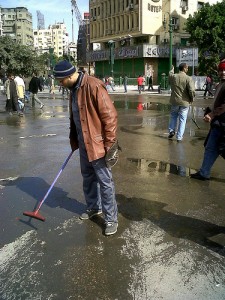Taking to the streets and squares.

Much has been made of the role of social media in supporting citizen action in the recent oustings and unrest in Middle East. But it must not be forgotten that much of the protest took place, not with individuals at home on laptops or computers, but out en masse in public space. Maybe media such as twitter enables such 'mob' networking on the move and sustains and encourages a feeling of common sense of space through synchronous communication with a wider background community. But the urban public space created a framework for gathering and for demonstrating a presence and a will to be counted. Much of the protests have been bylined with references to this - how protesters 'take to the streets' or 'reclaim the square' showing how spatial the right to free speech is in practice, since location is so often central to the message.
This is manifested in the day-to-day activities revolving around the occupation of a public space, reflected in the blog by Eman AbdElRahmanwho says
'there is another side to the ongoing revolution in Egypt, which is the daily life of those people sitting in on Tahrir Square. For the past 12 days, they have remained on the square, eating, drinking, chanting, cheering - simply living there day and night. Life here has its own rhythm now, and the spirit on display is of a mini Utopia.'
Of course temporarily living in a public space also has practical implications, as blogged by Eman AbdElRahman:@Maysaloon from Syria on Twitter:
Had a thought today, what are all those people in Tahrir Square doing for sanitation? I don't see any cubicles anywhere…
And so I replied:
Either they use nearby mosques' or underground public toilets, or nearby buildings, or shops. Some even return home & come back.
For instance @TAFATEFO tweeted while staying on Tahrir Square himself:
Someone said on the loudspeakers that he is a representative from the 3 buildings on the square. They said they opened their 6th and 7th floors to anyone wants to take a shower or sleep.
From the images it seems that the protestors took care of Tahrir Square during their occupation. (Photo by Monasosh on Flickr (CC-BY 2.0).
(Photo by Monasosh on Flickr (CC-BY 2.0).
More generally, the role of public space has been documented in photos (both professional and personal) and also on mapping visualisations: BBC slideshow of the square in the space of a day, hypercities twitter visualisation real-time, BBC Map of unrest on Tahrir (Liberation) Square, Egypt, Map of social media related to the protests in Egypt since January 25, 2011, Pearl Square, Bahrain, NY times images, and also out of the spotlight Ba Dinh Square in Vietnam
In Tunisia the new regime already memorialised one of the instigators of the uprising, renaming '7 September Square' (the day the previous leader came to power) as Mohammad Bouazizi Square.

